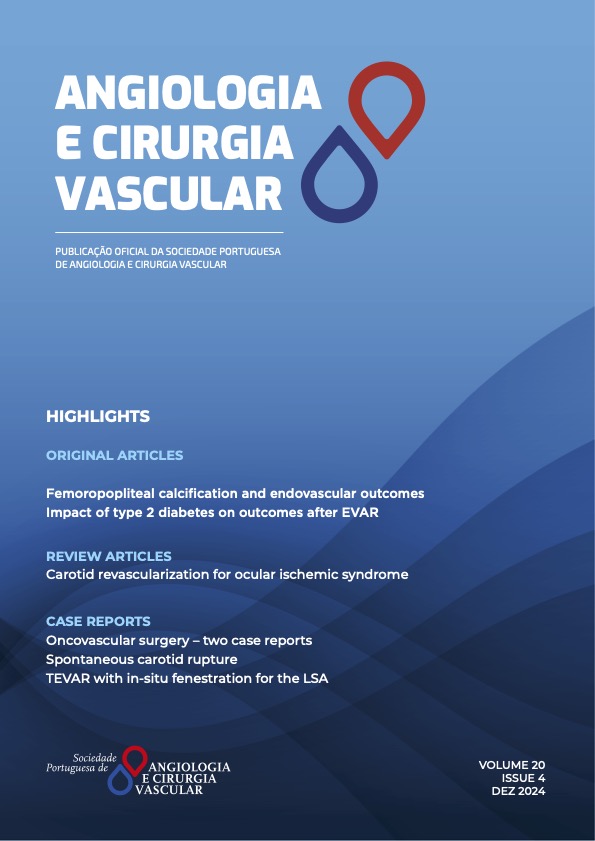The role of femoropopliteal calcification pattern on outcomes after endovascular treatment of patients with peripheral arterial disease
DOI:
https://doi.org/10.48750/acv.643Keywords:
Peripheral artery disease, calcification, endovascular, femoropopliteal, angioplastyAbstract
INTRODUCTION: Peripheral arterial calcification is typically most prominent in the femoropopliteal (FP) segment, and its effect on endovascular treatment (EVT) processes and outcomes is poorly understood. This study aimed to evaluate the impact of the pattern of FP calcification on EVT outcomes.METHODS: We designed a retrospective, single-center, comparative study. From January 2023 to February 2024, all patients with peripheral arterial disease who underwent EVT by a single operator as a first limb revascularization procedure for FP lesions only were considered. The calcification pattern was assessed through a qualitative fluoroscopic and angiographic evaluation. According to the degree of calcification, the patients were grouped into mild to moderate calcification (MC) and severe calcification (SC). Both groups were compared regarding the primary endpoints: reintervention rates, amputation and overall survival.
RESULTS: The study included 45 patients, of which 8 (18%) presented with intermittent claudication and 37 (82%) with chronic limb threatening ischemia. The median time of follow-up was 7 months. The MC group included 71% of the patients and the SV group included 29%. The median femoropopliteal GLASS classification was 4 in both groups. No statistically significant differences were found between groups in rates of reintervention (p=0.97), amputation (p=0.86) and overall survival (p=0.45). There were two major amputations in the MC group and one in SV group after eleven months of follow-up. Higher rates of subintimal angioplasty (38% vs. 12%, p=0.048) and contralateral retrograde access (54% vs. 22%, p=0.03) were found in the SC group.
CONCLUSIONS: In our cohort, highly calcified FP lesions were statistically related to contralateral retrograde access and subintimal cross-lesion pathway. However, the degree of calcification did not influence the most relevant clinical outcomes.
Downloads
References
Dong Y, Liu Y, Cheng P, Liao H, Jiang C, Liu S, et al. Lower limb arterial calcification and its clinical relevance with peripheral arterial disease. Front Cardiovasc Med. 2023;10:1271100.
Edmonds ME. Medial arterial calcification and diabetes mellitus. Z Kardiol. 2000;89 Suppl 2:101-4.
Bishop PD, Feiten LE, Ouriel K, Nassoiy SP, Pavkov M, Ckair DG, et al. Arterial calcification increases in distal arteries in patients with peripheral arterial disease. Ann Vasc Surg. 2008;22:799-805.
Mizobuchi M, Towler D, Slatopolsky E. Vascular calcification: the killer of patients with chronic kidney disease. J Am Soc Nephrol. 2009;20:1453-64.
London GM, Guérin AP, Marchais SJ, Métivier F, Pannier B, Adda H. Arterial media calcification in end-stage renal disease: impact on all-cause and cardiovascular mortality. Nephrol Dial Transplant. 2003;18:1731-40.
Okuno S, Iida O, Shiraki T, Fujita M, Masuda M, Okamoto S, et al. Impact of calcification on clinical outcomes after endovascular therapy for superficial femoral artery disease: Assessment using the peripheral artery calcification scoring system. J Endovasc Ther. 2016;23:731-7.
Hou B, Gang Q, Li X, Lun Y, Jiang H, Shen S, et al. Clinical implications of diverse calcification patterns in endovascular therapy for femoral-popliteal arterial occlusive disease. J Vasc Surg. 2024;80:188-98.
Rundback J, Kawai K, Sato Y, Brodmann M, Schneider P, Corbet MB, et al. Treatment effect of medial arterial calcification in below-knee after Auryon laser atherectomy using micro-CT and histologic evaluation. Cardiovasc Revasc Med. 2023;57:18-24.
Mustapha JA, Diaz-Sandoval LJ, Saab F. Infrapopliteal calcification patterns in critical limb ischemia: diagnostic, pathologic and therapeutic implications in the search for the endovascular holy grail. J Cardiovasc Surg (Torino). 2017;58:383-401.
Haraguchi T, Tsujimoto M, Kashima Y, Kasai Y, Sato K, Fujita T. Efficacy and safety of the needle rendezvous technique for infrainguinal arterial calcified lesions. CVIR Endovasc. 2024;7:77.









